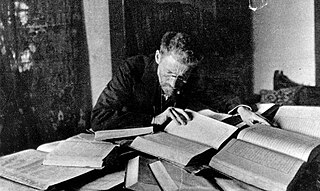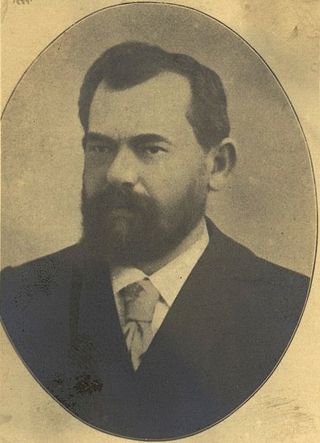
Shmuel Yosef Agnon was an Austro-Hungarian-born Israeli novelist, poet, and short-story writer. He was one of the central figures of modern Hebrew literature. In Hebrew, he is known by the acronym Shai Agnon. In English, his works are published under the name S. Y. Agnon.

The Haskalah, often termed as the Jewish Enlightenment, was an intellectual movement among the Jews of Central and Eastern Europe, with a certain influence on those in Western Europe and the Muslim world. It arose as a defined ideological worldview during the 1770s, and its last stage ended around 1881, with the rise of Jewish emancipation.

Moshe Chaim Luzzatto, also known by the Hebrew acronym RaMCHaL, was a prominent Italian Jewish rabbi, kabbalist, and philosopher.

Israeli literature is literature written in the State of Israel by Israelis. Most works classed as Israeli literature are written in the Hebrew language, although some Israeli authors write in Yiddish, English, Arabic and Russian.

Modern Hebrew, also called Israeli Hebrew or simply Hebrew, is the standard form of the Hebrew language spoken today. Developed as part of Hebrew's revival in the late 19th century and early 20th century, it is the official language of the State of Israel, and the world's only Canaanite language in use. Coinciding with the creation of the state of Israel, where it is the national language, Modern Hebrew is the only successful instance of a complete language revival.

Hayim Nahman Bialik was a Jewish poet who wrote primarily in Hebrew and Yiddish. Bialik is considered a pioneer of modern Hebrew poetry, part of the vanguard of Jewish thinkers who gave voice to a new spirit of his time, and recognized today as Israel's national poet. Being a noted essayist and story-teller, Bialik also translated major works from European languages.

Jewish literature includes works written by Jews on Jewish themes, literary works written in Jewish languages on various themes, and literary works in any language written by Jewish writers. Ancient Jewish literature includes Biblical literature and rabbinic literature. Medieval Jewish literature includes not only rabbinic literature but also ethical literature, philosophical literature, mystical literature, various other forms of prose including history and fiction, and various forms of poetry of both religious and secular varieties. The production of Jewish literature has flowered with the modern emergence of secular Jewish culture. Modern Jewish literature has included Yiddish literature, Judeo-Tat literature, Ladino literature, Hebrew literature, and Jewish American literature.
Abulafia or Abolafia is a Sephardi Jewish surname whose etymological origin is in the Arabic language. The family name, like many other Hispanic-origin Sephardic Jewish surnames, originated in Spain among Spanish Jews (Sephardim), during the time when it was ruled as Al-Andalus by Arabic-speaking Moors.

The revival of the Hebrew language took place in Europe and Palestine toward the end of the 19th century and into the 20th century, through which the language's usage changed from purely the sacred language of Judaism to a spoken and written language used for daily life in Israel. The process began as Jews from diverse regions started arriving and establishing themselves alongside the pre-existing Jewish community in the region of Palestine in the first half of the twentieth century. Arabic-speaking Jews in Palestine and the linguistically diverse newly arrived Jews switched to Hebrew as a lingua franca, the historical linguistic common denominator of all the Jewish groups. At the same time, a parallel development in Europe changed Hebrew from primarily a sacred liturgical language into a literary language, which played a key role in the development of nationalist educational programs. Modern Hebrew was one of three official languages of Mandatory Palestine, and after the Israeli Declaration of Independence in 1948, one of two official languages of Israel, along with Modern Arabic. In July 2018, a new law made Hebrew the sole official language of the state of Israel, giving Arabic a "special status".
Modern Hebrew poetry is poetry written in the Hebrew language. Moshe Chaim Luzzatto is considered one of the earliest modern Hebrew poets.

Yitzhaq Shami was a Palestinian Jewish and Israeli writer, who wrote both in Arabic and Hebrew. He is one of the earliest modern Hebrew literature writers in Palestine, prior to Israeli statehood. His work was unique for his period, since in contrast with the vast majority of Hebrew writers of the period he crafted his art based on characters who were either Arabs or Sephardic Jews, residing in the Ottoman Palestine, and his literary influences were predominantly Arab and Middle Eastern. Shami published short stories, one novella, several poems and a number of essays.
Musar literature is didactic Jewish ethical literature which describes virtues and vices and the path towards character improvement. This literature gives the name to the Musar movement, in 19th century Lithuania, but this article considers such literature more broadly.
The following outline is provided as an overview of and topical guide to Judaism:
The golden age of Jewish poetry in Al-Andalus developed in the literary courts of the various taifas. Like its Arabic counterpart, its production diminished in the 12th century under the rule of the Almoravids and Almohads. In the last part of the 10th century, Dunash ben Labrat revolutionized Jewish poetry in Al-Andalus by bringing Arabic meter and monorhyme into Hebrew writing. Jewish poets employed Arabic poetic themes, writing bacchic poetry, garden poetry, and love poetry.
Eastern Sephardim are a distinctive sub-group of Sephardic Jews mostly descended from Jewish families which were exiled from Iberia in the 15th century, following the Alhambra Decree of 1492 in Spain and a similar decree in Portugal five years later. This branch of descendants of Iberian Jews settled across the Eastern Mediterranean.

Sidra DeKoven Ezrahi is Professor Emerita of Comparative Literature at the Hebrew University of Jerusalem.

Yehudah Leib ha-Levi Levin, also known by the acronyms Yehalel and Yehalal, was a Hebrew socialist maskilic Hebrew poet, writer, and publicist. His poems were the first to introduce socialist themes into Hebrew literature.

Joseph (Yossi)Chetrit is Emeritus Professor of the French language and literature department and the Hebrew language department at the University of Haifa, former head of the Centre for the Study of Jewish Culture in Spain and Muslim Countries, and founder of the Tsfon-Maarav Troupe.












